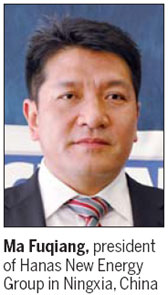Hanas seeks LNG partners in US
Updated: 2013-09-13 07:25
By Zhang Yuwei in New York (China Daily)
|
|||||||||||
China and the United States - the world's two largest economic superpowers - will have more opportunities to work together in the liquefied natural gas industry in the next 10 to 15 years, due to China's increasing demand and the US' supply ability and "appealing" prices, said Ma Fuqiang, president of China's Hanas New Energy Group.
Ma said that the structure of the global energy market is changing and that in the next 10 to 15 years, "we'll likely see China and India consuming more natural gas, and that's when the US will play an important role".
Ma led a delegation comprising about a dozen Hanas employees on an exploratory tour of the US.
He said he believes this trend will create projects that the world's two largest economies can work closely together on and hopes to find partners that Hanas can form a joint venture with to develop LNG projects by the "end of this year", without disclosing names of the possible partners they are considering. The investment value will be "around $5 billion", said Ma.
LNG, which is mainly methane, refers to natural gas that has been converted to liquid form for ease of storage or transport.
"We see the LNG business as a core company strategy for Hanas in the coming years," said Ma, who attended a recent annual seminar for owners and operators of LNG projects hosted by Air Products and Chemical Inc, a Pennsylvania-based gas company.
Hanas has been using Air Products' LNG technology since 2009.
Ma said the US market has great potential for Asia and emerging markets because its supply of LNG, in particular, will exceed its own market's demand in the next decade.

"The possible largest clients for the US are in Asia and emerging markets," said Ma, adding that US prices are more "appealing" than those of Russia, the Middle East or Australia.
Ma's 15-day trip to the US included visits to LNG plants and wind-turbine manufacturers in Nevada and Washington states.
Hanas was founded by Ma in 2010 in the Ningxia Hui autonomous region in Northwest China. Compared with some State-owned enterprises such as China Petroleum & Chemical Corp and China National Offshore Oil Corp, the young company doesn't have a significant market share in China, said Ma.
However, the Chinese market is big and the need for better energy solutions will create ample opportunities for firms like Hanas as China's urbanization drive picks up, Ma said.
The company has been mostly engaged in LNG production, gas-fired cogeneration projects for heating and power and urban gas networks.
In July 2012, Hanas put into operation an LNG plant in Yinchuan, the capital of Ningxia, the largest factory of its kind in China. The plant has been helping generate sustainable energy supplies for the country's western region.
China - the world's second-largest energy consumer and producer - is slated to have an annual natural gas consumption of 260 billion cubic meters by 2015.
Research firm Sanford C. Bernstein & Co estimated the number of vehicles fueled by LNG in China will rise 10-fold to 800,000 by 2020. The increase will create opportunities for LNG imports and the country is expected to become the top export destination for LNG.
With its huge population and the fast pace of its urbanization process, China needs to replace coal with natural gas in the coming years to move onto a sustainable path, said Ma.
He added it's time that China explores channels for importing fair-priced LNG to meet the increasing energy demand.
yuweizhang@chinadailyusa.com
(China Daily 09/13/2013 page14)
Today's Top News
Assad agrees to hand over chemical weapons
Rail route to Europe improves freight transport
3 sentenced to death for Xinjiang terror attack
China sets caps for rare earths exploration
Xi welcomes Iran nuclear talks
Moves against China firms criticized
China gets tough on air pollution
Developing nations need shift to balanced growth
Hot Topics
Lunar probe , China growth forecasts, Emission rules get tougher, China seen through 'colored lens', International board,
Editor's Picks

|

|

|

|

|

|





